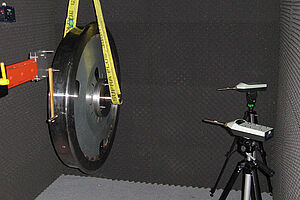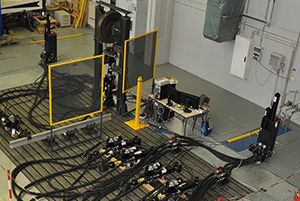
Servo hydraulic vibration test bench
On the plant side, the new large-scale test stand essentially consists of the hydraulic power unit, the hydraulic cylinders and the components for control and regulation technology. There are two hydraulic connection units (HSM), each with two independent test stations. Due to the modular design, up to 4 independent tests can be run simultaneously. The test stand currently has six servo-hydraulic, double-acting working cylinders.
The eight by four meter steel clamping surface is located on a 200 ton seismic mass. This mass rests on six air springs that are level-controlled.
This test rig makes it possible to dynamically test components from the rail vehicle sector. Tests with quasi-static load application are also possible.
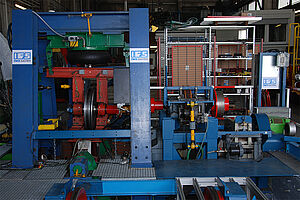
Single wheel rolling test bench
At the moment, the rolling test bench is arranged for testing the wheel-rail contact with single wheels. The rail is represented by a driving wheel with a wheel diameter of 1,3 m. In this test bench wheel slide protection experiments, as well as traction and braking tests, can be carried out. The drive unit has a rotating mass, which replaces the mass of a railway vehicle. Fluid, sand or damp foliage can be added on the rail surface with auxiliary devices.
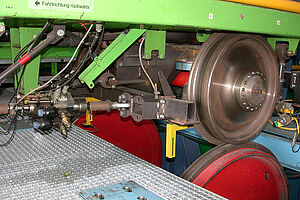
Single-axle test bench
Apart from the rolling test bench arranged for wheel slide protection and braking tests, this track guidance test bench for single axles is available at the institute for testing track guidance effects. The trailing wheelset can be radially adjusted in the test bench by means of a rotating device and, consequently, the wheel flange contact can be provoked. This test bench is also used for testing the generation and detection of flat spots.
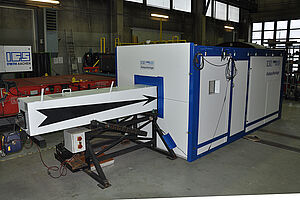
Catapult test unit
It usually happens in the railway traffic, especially at high operating speeds, that the vehicles and the infrastructure get damaged by ballast pick-up and ice debris.
The catapult test unit is mainly used for shooting at components with gravel stones and ice masses. Examples of test objects are cover parts of railway vehicles as well as wheelset axles and ETCS balises. With the catapult, projectile velocities of up to 280 km/h can be reached. The tests can be recorded with a high speed camera through an observation window.
Since the material behaviour is often temperature-dependent, the test objects can be heated up or cooled down to the expected operating temperature. Protective coatings of wheelset axles, underbody coverings and control equipment housings have been tested so far.
However, impact tests can be carried out for applications from outside the sector too. Strengthening the system would come into consideration if higher velocities were needed. In preliminary tests masses of 10 kg have already been accelerated to 500 km/h.
Acoustic chamber
The acoustic chamber is used for comparative sound-technical investigations. It has been equipped with soundproof elements to this effect. For instance, the noise emission generated by components of railway vehicles that have been excited by mechanical impacts can be investigated.
The adjoining picture shows the investigation of a railway track wheel with and without noise absorbers. This project was performed in cooperation with the Bochumer Verein Verkehrstechnik GmbH.
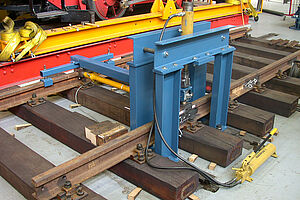
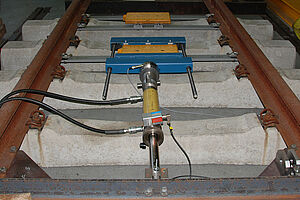
Measuring tracks
The institute has a 9-meter-long measuring track, which is suitable for both quasi-static wheel-rail contact (Y and Q forces) and investigations regarding flat spots at low speeds. Y and Q forces can be introduced in the railhead by means of a hydraulic pressing device and, consequently, the function of a curved measuring track can be approximately emulated. The measuring track is composed of wooden sleepers and rails of profile 49 E 1 (S 49) with K type fastening system.
Another measuring track with B70 concrete sleepers and rail profile type 60 E 1 (UIC 60) with W type fastening system is also available. This is used for the investigation of infrastructural facilities in high-speed traffic, for example to determine the quality of the holding systems used to fasten the ETCS-Eurobalises.
Measuring equipment
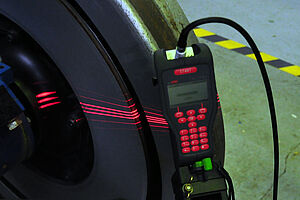
Mobile wheel/rail profile measurement system
Since 2015 the institute owns a modern contactless profile measurement system. It can be used both for the determination of the relevant dimensions of wheels and wheelsets and for the measurement of rail surfaces and the track gauges. Generally, every bar profile and body contour can be evaluated.
The calibrated system is qualified for the workshops of the Deutsche Bahn AG.
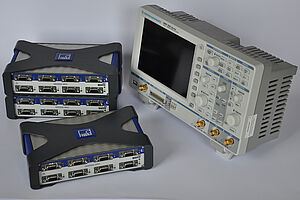
Stationary and mobile equipment
Apart from established measurement systems with carrier frequency measuring amplifiers, up-to-date compact measurement systems are used at the institute.
For stationary use, HBM and RMP measuring amplifiers with carrier frequency and equipped with A/D converters are used externally (USB/Gleitmann) and internally (integrated measurement board/National Instruments).
For mobile applications various universal measurement amplifiers “QuantumX” by HBM are available, which can be used as master/slave units as well.
In the test vehicle and the rolling test bench, real-time measuring and control tasks are performed by dSpace computers.
For diverse measuring tasks and experimental setups, a large amount of sensors and measurement cables suited to our specific applications in the railway vehicles sector are available and regularly updated. The equipment is assembled, and if necessary completed, depending on the requirements of the projects.
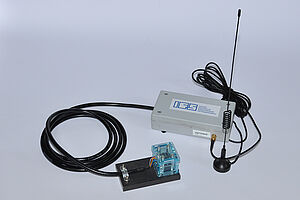
Mobile vibration measuring system
Frequently, the normal passenger service has to be limited during dynamic vibration measurements within the passenger compartment in order to place bulky measuring equipment. For this reason, a mobile and compact solution for the metrological detection of dynamic motion quantities in vehicles has been developed at the IFS. It is not dependent on an external power supply and it can be fixed to the vehicle floor in only a few minutes.
In vehicle dynamics the accelerations and velocities of the carriage body are of particular interest and it is often necessary to link them with the track description. Because of this, it is possible to estimate a georeferenced route mapping by merging the measured sensor data, so that all the registered information can be mapped and located.


